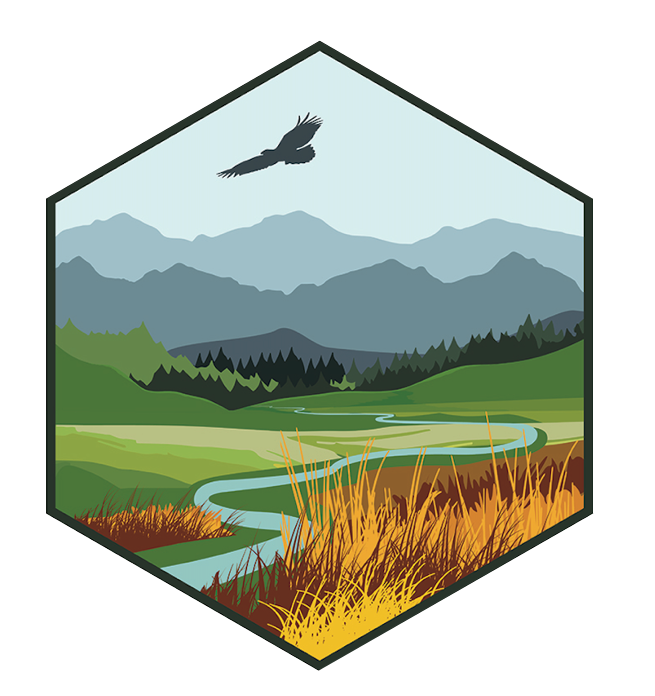October 2022 Tribal Climate Newsletter is Available Online
Interannual variation, especially weather, is an often-cited reason for restoration “failures”; yet its importance is difficult to experimentally isolate across broad spatiotemporal extents, due to correlations between weather and site characteristics. We examined post-fire treatments within sagebrush-steppe ecosystems to ask: (1) Is weather following seeding efforts a primary reason why restoration outcomes depart from predictions? and (2) Does the management-relevance of weather differ across space and with time since treatment? Our analysis quantified range-wide patterns of sagebrush (Artemisia spp.) recovery, by integrating long-term records of restoration and annual vegetation cover estimates from satellite imagery following thousands of post-fire seeding treatments from 1984 to 2005. Across the Great Basin, sagebrush growth increased in wetter, cooler springs; however, the importance of spring weather varied with sites' long-term climates, suggesting differing ecophysiological limitations across sagebrush's range. Incorporation of spring weather, including from the “planting year,” improved predictions of sagebrush recovery, but these advances were small compared to contributions of time-invariant site characteristics. Given extreme weather conditions threatening this ecosystem, explicit consideration of weather could improve the allocation of management resources, such as by identifying areas requiring repeated treatments; but improved forecasts of shifting mean conditions with climate change may more significantly aid the prediction of sagebrush recovery.
Accurate predictions of ecological restoration outcomes are needed across the increasingly large landscapes requiring treatment following disturbances. However, observational studies often fail to account for nonrandom treatment application, which can result in invalid inference. Examining a spatiotemporally extensive management treatment involving post-fire seeding of declining sagebrush shrubs across semiarid areas of the western USA over two decades, we quantify drivers and consequences of selection biases in restoration using remotely sensed data. From following more than 1,500 wildfires, we find treatments were disproportionately applied in more stressful, degraded ecological conditions. Failure to incorporate unmeasured drivers of treatment allocation led to the conclusion that costly, widespread seedings were unsuccessful; however, after considering sources of bias, restoration positively affected sagebrush recovery. Treatment effects varied with climate, indicating prioritization criteria for interventions. Our findings revise the perspective that post-fire sagebrush seedings have been broadly unsuccessful and demonstrate how selection biases can pose substantive inferential hazards in observational studies of restoration efficacy and the development of restoration theory.
A rapidly changing climate during this century poses a high risk for impacts to ecosystems, biodiversity and traditional livelihoods. A better understanding of how climate change might alter temperature, precipitation, heat stress, water availability and other extreme weather metrics in the coming century would be useful to natural resource managers at the U.S. Fish & Wildlife Service in the North Central region. Particularly, when they prepare to conduct Species Status Assessments to better evaluate risk to ecosystems, biodiversity and traditional livelihoods resulting from a changing climate. Scientists have traditionally gone through the time intensive process of extracting and analyzing different climate datasets (e.g., temperature and precipitation) to produce a comprehensive quantitative summary for different climate scenarios. However, these methods have not been efficient in meeting the growing demand and is challenging the capacity of the human resources. This project aims to develop a web-based interactive tool to deliver such information in a much more timely and user-friendly manner. This research project will develop an interactive tool using the existing computational and data-intensive platform provided by the Climate Toolbox, a highly recognized data delivery and climate analytic tool. Using this existing structure to develop this much needed tool will make the process more efficient, cost effective, and assure its long-term maintenance. The US Fish & Wildlife Service, the National Park Service and regional Tribe cooperators will inform the development of this tool, including developing new datasets and functionalities for the tool, and assessing its usability. The resulting open-source tool will be accessible and applicable to a wide variety of CASC-stakeholders across the contiguous United States.
Atmospheric warming is driving a shift in precipitation from snow to rain, changing precipitation intensity and seasonality, and increasing atmospheric demand for moisture in mountain river watersheds across the western United States. These changes will likely alter the timing and quantity of streamflow in rivers draining from the mountains. The Tongue River flows from the Bighorn mountains in north-central Wyoming into Montana through alpine meadows to sagebrush steppe, prior to its confluence with the Yellowstone River at Miles City, MT. The Tongue River is a little-studied river with hydrologic conditions (e.g. water flow, temperature, quantity) relevant to Tribal water rights and management, fisheries, interstate water rights, irrigation, and reservoir operations. A better understanding of the current and future hydrology of the Tongue River watershed will help Tribal water management professionals make data-driven decisions about how to manage, lease, and utilize their water rights. This project will use future hydrology estimates (2070-2099) from a previously published database containing two future climate scenarios and 32 different climate models. These data will be used in conjunction with a river system model and input from the Northern Cheyenne Tribe, a project partner, and other area stakeholders to produce estimates and analyses of future streamflow throughout the Tongue River watershed. The river system model will account for irrigation withdrawals and reservoir operations, allowing for future streamflow estimates that include these processes. Project researchers will work with Northern Cheyenne Tribal members and resource managers to ensure that the project analyses are useful for their management objectives.
Dry stream sections are characteristic of most prairie streams. Native fish are highly adapted to variable environments, using refuge habitats (e.g., remaining wet stream fragments) to recolonize areas after seasonal drying. However, dams and other barriers can prevent recolonization of seasonally-dry stream sections habitats known to be critical spawning and rearing areas for many species. This phenomenon will likely become more common as climate change causes increasingly severe droughts, and larger sections of streams become seasonally dry. This could lead to local loss of native prairie fishes, an already at-risk group. Fisheries managers in Wyoming and Montana have limited data on climate impacts to prairie fishes, limiting their ability to prioritize management actions. This is in part because the ecology and possible climate adaptation strategies for many prairie fishes are poorly understood. Managers also have limited time to assess the success of potential restoration actions to increase fish resilience to seasonal drying and ways to increase refuge habitat. This project aims to provide landscape-level maps and resources that will help managers prioritize where and for which species management actions, such as water and habitat conservation and restoration measures, could be most beneficial. A research team will assess which species are most sensitive to drought in addition to expanding a newly created model of streamflow permanence to map drought refuges for vulnerable species. The project will also monitor stream restoration case studies to determine if process-based restoration techniques can be used to increase streamflow permanence and connectivity. Lastly, this work will be leveraged to create a short, species-specific guide to climate adaptation techniques. This guide will help agencies, landowners, conservation districts, and public interest groups determine what can be done to benefit at-risk species in their area of interest.
The Northern Glaciated Plains in the upper Midwest United States is a region where fishing generates millions of dollars a year for local and state economies. Maintaining these revenues requires the management of fish populations that are popular and accessible (e.g. boat ramps, public land access) to anglers. Fisheries throughout the world are currently undergoing unprecedented changes to water levels and habitat quality resulting from climate change. The consequences of climate change to Northern Glaciated Plains fisheries are unknown but pose an immediate challenge for resource managers as angler access and opportunities can be jeopardized when: a) boat ramps become inaccessible due to changing water levels, and b) altered water quality negatively affects desired fish species. This project aims to provide fisheries managers with information about how climate change may alter the hydrology of Northern Glaciated Plains lakes and the impact those changes may have on fish communities, angler access, angler behavior, and angler expenditures. A hydrologic model will be used to predict changes in lake size and water quality based on weather conditions under a changing climate. This information will then be used to 1) predict changes in fish communities, 2) identify current angler access locations that are at risk of becoming inaccessible, 3) determine whether anglers will change the amount of time they spend fishing, and 4) decern how these changes ultimately affect the amount of money anglers spend in this region. By understanding which lakes will experience change and how, fisheries managers will be able to make decisions at state or regional levels about infrastructure development (number and location of new boat ramps) and ecosystem management (species and locations of fish stocking) that will maintain angler satisfaction and the economic benefits of recreational fisheries.
The Northwest and North Central Climate Adaptation Science Centers (NW and NC CASCs) work in partnership with regional natural resource management communities to provide high priority science information and products needed for climate adaptation. In parallel with the U.S. Fish and Wildlife Service (USFWS) Region 6, the NW and NC CASCs prioritize science to inform sagebrush steppe and grassland ecosystem conservation, emphasizing the application of climate adaptation strategies that support at-risk populations and human-ecological communities within these ecosystems. To improve their ability to deliver effective and actionable science, the NW and NC CASCs must continually engage with regional partners and stakeholders to understand their natural resource management priorities. Through this project, the NW and NC CASCs are working closely with USFWS staff to help achieve CASC and USFWS objectives for delivering actionable science. The project team is working on a range of efforts, including: Identifying ways to fill climate information needs for Endangered Species Act (ESA) Species Status Assessments for at-risk species, including sagebrush- and grassland-associated species, by engaging closely with USFWS Endangered Species Coordinators and biologists in Montana, Wyoming, Colorado, Utah, Kansas, Nebraska and North and South Dakota, Developing and disseminating resource management-relevant scientific products generated through projects funded by the NW and NC CASCs and the Landscape Conservation Cooperatives (Great Northern, Southern Rockies, Plains and Prairie Potholes), Gauging the climate adaptation training needs of tribal, federal, state, and local natural resources managers, especially in sagebrush steppe and grassland ecosystems with the goal of creating a Western Climate Adaptation Training Center, and Expanding the range of regional partners that the NW and NC CASCs work with. This work will facilitate the NW and NC CASCs’ ability to inform climate adaptation management approaches through applied science and targeted adaptation training.


